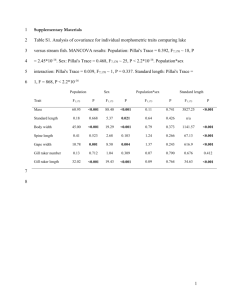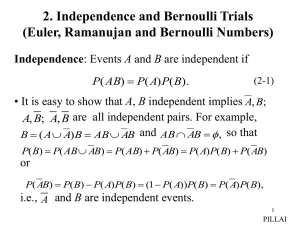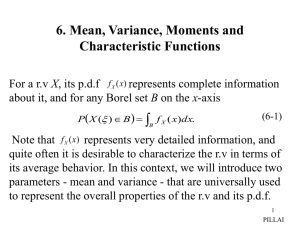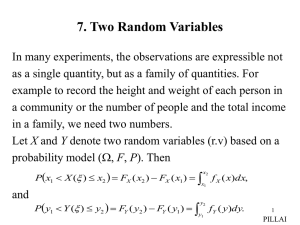- University of Surrey
advertisement
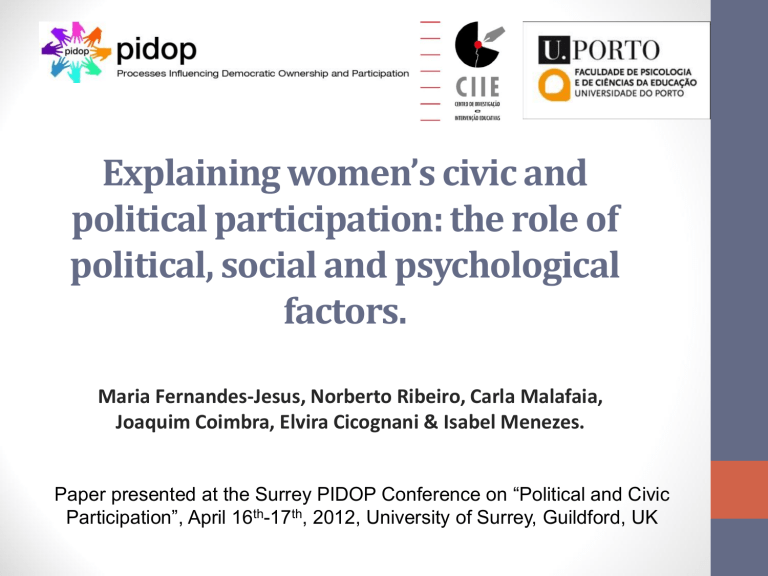
Explaining women’s civic and political participation: the role of political, social and psychological factors. Maria Fernandes-Jesus, Norberto Ribeiro, Carla Malafaia, Joaquim Coimbra, Elvira Cicognani & Isabel Menezes. Paper presented at the Surrey PIDOP Conference on “Political and Civic Participation”, April 16th-17th, 2012, University of Surrey, Guildford, UK Concerns about women participation • Gap gender – different levels of participation or different forms of be engaged? (Andersen, 1997; Burns 2007; Paxton, Kunhovich & Hughes, 2007) • A political need - women from different cultures and background need to be included in public and private arenas (Lister et. al, 2007) • Creating models of participation under the assumption that participation is influenced by several factors and dimensions. The sample The data was collected by the Portuguese team of PIDOP Forms of participation Levels of participation Levels of participation Conventional CPP Portuguese Angolans Brazilian Total Male > Female Female > Male Female > Male PT> BRA> ANG Female > Male Female > Male BRA> PT> ANG Participation on the net Male = Female Civil disobedience Male> Female Female > Male Female > Male Economic participation Female > Male Female > Male Female > Male Vote in elections Female > Male Female > Male Male> Female PT> BRA> ANG PT> BRA> ANG BRA> PT> ANG In general: - Reduction of the gender gap in terms of levels of participation… - Inversion of the gap gender on the minority groups… but… Gender ≠s on participation PT ANG BRA Action Pillai´s Trace=.059, F(5,372)=4.659, p≤.0001 Pillai´s Trace=.049, F(5,238)=2.476, p=.033 Pillai´s Trace=.022, F(5,337)=1.530, p=.180 Conventional P=.877 P=.037; F>M P=.216 P=.031; F>M P=.708 P=.002; F>M P=.285 Civil desob. Economic P=.706 P≤.0001; F>M Efectiveness Pillai´s Trace=.069, F(5,370)=5.486, p≤.0001 Civil desob. P≤.0001; M>F Dispositions Pillai´s Trace=.058, F(5,369)=4.545, p≤.0001 Pillai´s Trace=.015, F(5,237)=.742; p=.593 Pillai´s Trace=.006, F(5,312)=.364, P=.873 Civil desob. P=.001; M>F P=.702 P=.960 Pillai´s Trace=.021, F(5,236)=1.026; p=403 P=.752 Pillai´s Trace=.009, F(5,316)=.582, p=.714 P=.236 Gender ≠s on political attitudes PT ANG BRA Political Interest& Attentiveness& Knowledge Pillai´s Trace=.042, F(3,358)=5.230, p=.002 Pillai´s Trace=.002, F(3,203)=1.916, p=.128 Pillai´s Trace=.009, F(3,285)=.911, p=.436 Interest P=.007; M>F P=.867 P=.818 Attentiveness P=.001; M>F P=.616 P=.193 knowlege P=.270 p=.025 F>M P=.390 Political Efficacy Pillai´s Trace=.046, F(3,384)=595.895, p≤.0001 Pillai´s Trace=.033, F(2,250)=2.817, p=.040 Pillai´s Trace=.015 F(2,349)=1.812, p=.145 Internal efficacy p≤.0001 M>F P=.107 P=.032 Lack (external) P=.609 P=.85 P=.993 Collective P=-979 P=.004 M>F P=.244 Gender ≠s on political attitudes PT ANG BRA Sense of Community & Social Well-being Pillai´s Trace=.010, F(2,379)=.1.303, p=.273 Pillai´s Trace=.037 F(3,249)=3.163, p=.025 Pillai´s Trace=.032 F(3,337)=3.741, p=.011 SW P=.559 P=.319 P=.002 M>F Opportunities YP P=.053 M>F P=.852 P=.293 Community change P=.605 P=.019 M>F P=.107 Support Minority Rights Pillai´s Trace=.085, Pillai´s Trace=.057, Pillai´s Trace=.030 F(3,383)=11.913 F(3,243)=4.927, F(3,228)=3.494, p≤.0001 p=.002 p=.016 Equal rights P≤.0001 F>M p=.006 F>M P=.068 Cultural rights P≤.0001 F>M P=.015 F>M P=.060 Positive discrimination P=.148 P=.011 M>F P=.152 Gender ≠s on political attitudes PT ANG BRA Motivations & Barriers Pillai´s Trace=.014, F(3,381)=1.812 p=.144 Pillai´s Trace=.030, F(3,250)=2.601, p=.053 Pillai´s Trace=.005 F(3,348)=.602, p=.614 Personal enhancement P=.022 P=.006 M>F P=.602 Social change P=.109 P=.013 M>F P=.570 Barriers P=.826 P=.830 P=.205 Trust Pillai´s Trace=.021, F(3,383)=2.794 p=.040 Pillai´s Trace=.069, F(3,246)=6.061, p=.001 Pillai´s Trace=.039 F(3,351)=4.776, p=.003 In others forms of governments P=.020 M>F P≤.0001 M>F P=.572 P=.053 M>F P=.587 P=.001 M>F P=.001 M>F In governments leaders P=.425 Interpersonal trust P=.036 M>F • We realize several dilutions of gender differences regarding the participation action, but slightly changes on political attitudes. Could this suggest the major role of political opportunities? • Gender differences on economic participation, with women revealing advantages, exception on Brazilian origin group • Maintenance of traditional gender differences (e.g., selfpolitical efficacy) • Inversion of the traditional gender gap (e.g., political knowledge) on the group with Angolan origin – cultural issues? • Brazilian youth are those who reported few gender ≠s • Angolan group is the group who show more gender ≠s • Portuguese group shown more advantages of men on political attitudes. Independently of the migrants status, let´s analyze the role of motivations, perceived effectiveness (Klandermans, 1997; 2002), political interests, political attentiveness (Van Deth & Elff; 2004) and sense of community community change (Ryan, Agnitsch, Zhao & Mullick, 2005) on participation in relation with the both gender…. Conventional forms of CPP Regression Weights: (Male - Default model) Est. S.E. C.R. P cpp <--- SOC - CC ,082 ,025 3,289 ,001 cpp <--- Effectiv. ,096 ,025 3,793 *** cpp <--- Motivat. ,009 ,016 ,572 ,567 cpp <--- Interest ,063 ,031 2,009 ,045 cpp <--- Attention ,056 ,028 1,984 ,047 Regression Weights: (Female - Default model) Est. S.E. C.R. P cpp <--- SOC - CC ,034 ,024 1,407 ,159 cpp <--- Effectiv. ,048 ,022 2,140 ,032 cpp <--- Motivat. ,017 ,019 ,901 ,367 cpp <--- Interest ,041 ,032 1,270 ,204 cpp <--- Attention ,095 ,030 3,130 ,002 Economic participation Regression Weights: (Male – Default model) Est. S.E. C.R. P Econ <-- SOC - CC ,044 ,044 ,991 ,321 Econ <-- Effectiv. ,305 ,064 4,764 *** Econ <-- Motivation ,025 ,033 ,759 ,448 Econ <-- Interest ,249 ,091 2,745 ,006 Econ <-- Attention ,058 ,072 ,801 ,423 Regression Weights: (Female – Default model) Est- S.E. C.R. P Econ <--- SOC - CC -,005 ,045 -,109 ,913 Econ <--- Effectiv. ,123 ,057 2,141 ,032 Econ <--- Motivation ,152 ,040 3,806 *** Econ <--- Interest -,119 ,083 -1,437 ,151 Econ <--- Attention ,379 ,076 4,996 *** Civil disobedience Regression Weights: (Male – Default model) Est. S.E. C.R. civilD <---,009 ,029 -,296 SOC - CC civilD <--civilD <--civilD <--civilD <--- Effectiv. Motivation Interest Attention P ,768 ,269 ,068 3,972 *** ,014 ,022 ,615 ,538 -,011 ,062 -,185 ,853 ,096 ,052 1,855 ,064 Regression Weights: (Female - Default model) Est. S.E. C.R. P civilD <- SOC - CC -,022 ,033 -,663 ,507 civilD <- Effectiv. ,221 ,051 4,314 *** civilD <- Motivation -,011 ,027 -,402 ,687 civilD <- Interest ,068 ,053 1,276 ,202 civilD <- Attention ,095 ,046 2,049 ,040 Participation on the Internet Regression Weights: (Male - Default model) Est S.E. C.R. P net <--- SOC - CC ,032 ,031 1,014 ,311 net <--- Effectiv. ,358 ,051 7,017 *** net <--- Motivation -,006 ,023 -,277 ,782 net <--- Interest ,201 ,069 2,918 ,004 net <--- Attention ,042 ,055 ,749 ,454 Regression Weights: (Female - Default model) Est S.E. C.R. P net <--- SOC - CC ,044 ,026 1,653 ,098 net <--- Effectiv. ,260 ,037 6,948 *** net <--- Motivation -,020 ,021 -,948 ,343 net <--- Interest ,122 ,043 2,836 ,005 net <--- Attention ,078 ,038 2,081 ,037 Vote Regression Weights: (Male - Default model) Est S.E. C.R. P vote <--- SOC - CC ,093 ,100 ,928 ,353 vote <--- Efficacy ,345 ,045 7,730 *** vote <--- Motivation ,009 ,076 ,114 ,909 Vote <--- Interest ,427 ,215 1,984 ,047 vote <--- Attention ,076 ,176 ,435 ,664 Regression Weights: (Female - Default model) Est S.E. C.R. P Vote <--- SOC - CC -,047 ,093 -,508 ,612 vote <--- Efficacy ,248 ,044 5,626 *** Vote <--- Motivation ,023 ,076 ,306 ,760 Vote <--- Interest ,407 ,149 2,737 ,006 vote <--- Attention ,122 ,129 ,945 ,345 • Perceived effectiveness of participation explain a significant part of all the forms of participation on both genders – consistent with the literature (Klandermans, 1997; 2002; Bandura, 2001) • Our models seems to better explains the variance on economic participation and also participation on the internet - different forms of participation have different predictors • Gender differentiation under the predictors of participation – sense of community seems to be important to explain conventional forms of civic and political participation of men (but not women). Motivations is a important predictor of women, but not men, economic participation • Excepting on vote, political attentiveness is one significant predictors of female participation behaviors (but not male) • There is no gender differences on the model of vote in elections efficacy and political interest Nevertheless, further analysis should considered that different groups can have different predictors of participation: ethnicity and migrant status… The PIDOP project is supported by a grant received from the European Commission 7th Framework Programme, FP7- SSH-2007-1, Grant Agreement no: 225282, Processes Influencing Democratic Ownership and Participation (PIDOP) awarded to the University of Surrey (UK), University of Liège (Belgium), Masaryk University (Czech Republic), University of Jena (Germany), University of Bologna (Italy), University of Porto (Portugal), Örebro University (Sweden), Ankara University (Turkey) and Queen’s University Belfast (UK)
